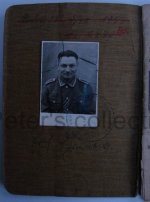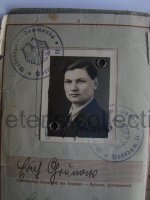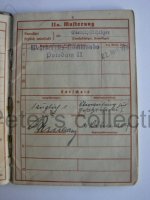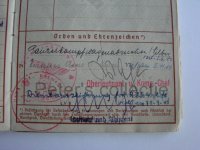Because both Soldbuch and Wehrpaß are still together it is possible to find out lots of detailed information of this soldier in the German army.
Erich Grunow (°1916) was educated as a mechanic but worked as an assistant for the German post.
On April 22 1936 he was medically examined and declared fit to serve but he isn’t immediately called to the army, instead he is placed in the army reserve and on October 25 1936 he begins his RAD service.
Apparently he likes his time in the RAD and decides to make it his career job, he rises through the ranks and in December 1937 he is promoted to the rank of Truppführer, a rank comparable to Feldwebel.
In November 1938 he is called up to serve his time in the army, he is assigned to 7/Panzer Rgt 8, an armored unit based in Böblingen and trained as a tank crewmember; he obtains a typ 2 drivers license for tracked vehicles and he follows a four day course for equipment and ammo nco’s but his main function is to be a wireless operator in a Pzkw III.
Two days before the war breaks out he is transferred to the 6th company of his regiment that is now the back bone of the 10th Panzer Division; the 10 Pz Div is attached to Guderians Corps in the first stage of the Polish campaign they are kept in reserve but after September 7 1939 they will participate in the advance towards Brest-Litovsk and on September 17 they link up there with the armored units of von Kleist, effectively surrounding the Polish army.
On October 1 1939 he is promoted to Panzeroberschütze and on Janury 1 1940 to Gefreiter.
In the campaign against France there will be a more prominent role for the tanks of the 10 Pz Rgt 8; they belong to the Gruppe von Kleist, the main assault force that will march through the Ardennes forest, cross the Meuse river and race towards the see and thus cutting the allied forces in two.
When the German tanks have crossed the Meuse river in Sedan, the German generals expect a French counter attack, to protect their left flank they detach Infantry Rgt Großdeutschland and the 10th Pz Div these two units now march south instead of east like the rest of the main force.
On May 15 1940 they reach Stonne and the French army indeed counter attacks, the fighting is fierce, the tiny village will change hands not less then 17 times in two days.
The tanks of Pz Rgt 8 will clash with the gigantic French Char B1 bis tanks, after two days of fighting the German tanks come out on top and on May 17 the 10 Pz Div is relieved and rejoins the other armored divisions in their race to the sea.
After the Westfeldzug he is awarded the Panzerkampfabzeichen and the EKII; he also is promoted to Obergefreiter.
On December 30 1940 he is admitted in to hospital for problems with the meniscus in his right knee, his medical condition is bad, he will remain in hospital until January 31 1942 and is unfit to serve in a frontline combat unit.
He remains in the reserve unit until June 1944, then he is transferred to the logistical unit of Panzer Abteilung Norwegen; he will stay in Norway until the end of the war.
His time in the army counts also as service in the RAD, so he is promoted to Truppführer and Haupttruppführer in 1944.
A nice detail.
- On the cover of his Soldbuch, just above his picture, you can see his weapon issue entry for a 08 pistol S/42 1936 Nr 2870.
Before page 8a was added to the Soldbucher, some units used the cover to write down the serial numbers of the issued weapons.
Erich Grunow (°1916) was educated as a mechanic but worked as an assistant for the German post.
On April 22 1936 he was medically examined and declared fit to serve but he isn’t immediately called to the army, instead he is placed in the army reserve and on October 25 1936 he begins his RAD service.
Apparently he likes his time in the RAD and decides to make it his career job, he rises through the ranks and in December 1937 he is promoted to the rank of Truppführer, a rank comparable to Feldwebel.
In November 1938 he is called up to serve his time in the army, he is assigned to 7/Panzer Rgt 8, an armored unit based in Böblingen and trained as a tank crewmember; he obtains a typ 2 drivers license for tracked vehicles and he follows a four day course for equipment and ammo nco’s but his main function is to be a wireless operator in a Pzkw III.
Two days before the war breaks out he is transferred to the 6th company of his regiment that is now the back bone of the 10th Panzer Division; the 10 Pz Div is attached to Guderians Corps in the first stage of the Polish campaign they are kept in reserve but after September 7 1939 they will participate in the advance towards Brest-Litovsk and on September 17 they link up there with the armored units of von Kleist, effectively surrounding the Polish army.
On October 1 1939 he is promoted to Panzeroberschütze and on Janury 1 1940 to Gefreiter.
In the campaign against France there will be a more prominent role for the tanks of the 10 Pz Rgt 8; they belong to the Gruppe von Kleist, the main assault force that will march through the Ardennes forest, cross the Meuse river and race towards the see and thus cutting the allied forces in two.
When the German tanks have crossed the Meuse river in Sedan, the German generals expect a French counter attack, to protect their left flank they detach Infantry Rgt Großdeutschland and the 10th Pz Div these two units now march south instead of east like the rest of the main force.
On May 15 1940 they reach Stonne and the French army indeed counter attacks, the fighting is fierce, the tiny village will change hands not less then 17 times in two days.
The tanks of Pz Rgt 8 will clash with the gigantic French Char B1 bis tanks, after two days of fighting the German tanks come out on top and on May 17 the 10 Pz Div is relieved and rejoins the other armored divisions in their race to the sea.
After the Westfeldzug he is awarded the Panzerkampfabzeichen and the EKII; he also is promoted to Obergefreiter.
On December 30 1940 he is admitted in to hospital for problems with the meniscus in his right knee, his medical condition is bad, he will remain in hospital until January 31 1942 and is unfit to serve in a frontline combat unit.
He remains in the reserve unit until June 1944, then he is transferred to the logistical unit of Panzer Abteilung Norwegen; he will stay in Norway until the end of the war.
His time in the army counts also as service in the RAD, so he is promoted to Truppführer and Haupttruppführer in 1944.
A nice detail.
- On the cover of his Soldbuch, just above his picture, you can see his weapon issue entry for a 08 pistol S/42 1936 Nr 2870.
Before page 8a was added to the Soldbucher, some units used the cover to write down the serial numbers of the issued weapons.
Attachments
-
 DSC06884.jpg41.1 KB · Views: 34
DSC06884.jpg41.1 KB · Views: 34 -
 DSC06885.jpg43 KB · Views: 43
DSC06885.jpg43 KB · Views: 43 -
 DSC06887.jpg55.2 KB · Views: 48
DSC06887.jpg55.2 KB · Views: 48 -
 DSC06887a.jpg53.3 KB · Views: 35
DSC06887a.jpg53.3 KB · Views: 35 -
 DSC06888.jpg60.2 KB · Views: 35
DSC06888.jpg60.2 KB · Views: 35 -
 DSC06889.jpg129.1 KB · Views: 30
DSC06889.jpg129.1 KB · Views: 30 -
 DSC06890.jpg70.4 KB · Views: 31
DSC06890.jpg70.4 KB · Views: 31 -
 DSC06891.jpg99.5 KB · Views: 28
DSC06891.jpg99.5 KB · Views: 28 -
 DSC06892.jpg117.9 KB · Views: 27
DSC06892.jpg117.9 KB · Views: 27 -
 DSC06893.jpg64.5 KB · Views: 27
DSC06893.jpg64.5 KB · Views: 27




































